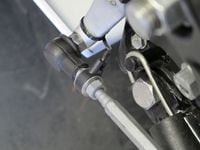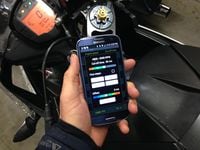WRIST: Ari Henning
MSRP (2015): $5,499
MILES: 2,460
MPG: 59
MODS: Healtech quickshifter
Nobody—not even a pro racer—is going to say quickshifters are necessary. They're just not. But a quickshifter is a helpful performance feature, one that also happens to be addictively fun to use on the street.
With small-bore bikes like the RC390 you row through the gearbox like a kayaker headed upstream, so I knew early on that I'd want to equip the KTM with a quickshifter to enable full-throttle clutchless upshifts. I'm familiar with the standalone quicksifter kits (as opposed to an accessory to a fuel controller) from Power Commander ($298 for the module, plus $216 for the sensor) and Bazzaz ($490 for the QS4-USB) and know from experience that they work well, but I was keen to find a more straightforward and affordable solution. Cue the magic of the Internet. A little searching uncovered the Healtech QSE (Quick Shifter Easy), distributed in the U.S. by bluemonkeymotorsports.com for an all-in price of $320.
The name pretty much sums it up. The Quick Shifter Easy is easy to install, easy to set up, and relative to other products on the market, it’s easy on your budget. The QSE also has a few unique and appealing features that set it apart, including a compact shift sensor, setup adjustability via the free Healtech smartphone app, and the fact that the sensor and module are universal so you can transfer them to another bike if you want. All it takes is a $40 wiring harness.
Installation was about as involved as making an omelette, accomplished in under 15 minutes thanks to the simplicity of the QSE and the fact that I already had the bodywork off the bike. (If I’d had to remove the bodywork and tank, the project would likely have taken another hour or so.) First you bolt up the shift sensor (see caption at right), mount the matchbox-size QSE module in a convenient location with the provided Velcro, and then hook up the wiring. That means plugging the shift sensor into the module, securing the ground wire, and plugging two OE-style connectors into the bike’s wiring harness at the fuel injector. Even if you’re intimidated by the thought of lubing your own chain, installing the QSE is definitely something you can handle.
With the quickshifter installed, you still need to set it up. I love the simplicity of the QSE hardware, and I'm equally impressed with the sophistication and ease of use of the QSE software. Using the Healtech app and a smartphone, you can set cut times based on rpm ranges as well as adjust the sensor sensitivity. I input the parameters recommended by the Blue Monkey techs outlined by reenmachine on rc390-forum.com and was good to go.
So how does it work? As well or better than the various OE and aftermarket systems I’ve tried. At first shifting at partial throttle was clunky, so I went in and reduced the cut time at lower RPM to smooth shifts around town. Now it’s succinct at partial throttle and absolute butter at wide-open throttle. I already loved stretching the KTM’s throttle cable, and now the bike is even more exciting to ride. Every morning I look forward to entering the highway onramp, rolling the throttle to the stop, and quickshifting up through the gears. And since the KTM only makes about about 40 horsepower, I’m still within the speed limit when I merge with traffic. This is small-bike living at its best!
I know what some of you are thinking: $320 just to give your clutch hand a rest? I’ll be the first to admit that quickshifters are a luxury and a novelty, but if you haven’t experienced how much fun they are to use then you’re not likely to get it. More and more bikes are now coming equipped with quickshifters (from BMW’s R1200RT to Yamaha’s new YZF-R1), so it’s clear there’s a demand for the feature. And for anyone that wants a quickshifter on a bike that didn’t come with one, there’s Healtech’s QSE.















/cloudfront-us-east-1.images.arcpublishing.com/octane/7GJYDUIPXRGMTMQKN6ONYOLBOU.jpg)
/cloudfront-us-east-1.images.arcpublishing.com/octane/MUQLOVLL2ZDGFH25ILABNBXKTI.jpg)
/cloudfront-us-east-1.images.arcpublishing.com/octane/TNOU5DNE2BC57MFPMGN2EIDXAM.jpg)
/cloudfront-us-east-1.images.arcpublishing.com/octane/GTCXACQGJ5HAPDTGWUQKDEH44E.jpg)
/cloudfront-us-east-1.images.arcpublishing.com/octane/S35YGSEMEZB4BLTDJTSZPF4GLA.jpg)
/cloudfront-us-east-1.images.arcpublishing.com/octane/5UOT6HPX2JFMRJAX6EH45AR4MQ.jpg)
/cloudfront-us-east-1.images.arcpublishing.com/octane/OKWOJWAKP5EP3OACCRRWPCIX2Q.jpg)
/cloudfront-us-east-1.images.arcpublishing.com/octane/2WF3SCE3NFBQXLDNJM7KMXA45E.jpg)
/cloudfront-us-east-1.images.arcpublishing.com/octane/G4MG6OUCJNBSHIS2MVVOTPX65E.jpg)
/cloudfront-us-east-1.images.arcpublishing.com/octane/IIGGWFOTOJGB7DB6DGBXCCMTDY.jpg)
/cloudfront-us-east-1.images.arcpublishing.com/octane/QSTCM6AVEZA5JJBUXNIQ3DSOF4.jpg)
/cloudfront-us-east-1.images.arcpublishing.com/octane/U4I7G625B5DMLF2DVIJDFZVV6M.jpg)
/cloudfront-us-east-1.images.arcpublishing.com/octane/B6XD6LS6IVCQPIU6HXDJSM3FHY.jpg)
/cloudfront-us-east-1.images.arcpublishing.com/octane/ICL63FEDDRDTTMINYICCEYGMDA.jpg)
/cloudfront-us-east-1.images.arcpublishing.com/octane/FCGZHQXRBZFLBAPC5SDIQLVF4I.jpg)
/cloudfront-us-east-1.images.arcpublishing.com/octane/WNOB6LDOIFFHJKPSVIWDYUGOPM.jpg)

/cloudfront-us-east-1.images.arcpublishing.com/octane/X33NU3E525ECRHXLNUJN2FTRKI.jpg)
/cloudfront-us-east-1.images.arcpublishing.com/octane/6KKT5NNL2JAVBOXMZYS5ZO76YA.jpg)
/cloudfront-us-east-1.images.arcpublishing.com/octane/J5RKG5O455GMPGQRF2OG6LRT7A.jpg)
/cloudfront-us-east-1.images.arcpublishing.com/octane/GX2CIZKQVRH2TATDM26KFG2DAE.jpg)
/cloudfront-us-east-1.images.arcpublishing.com/octane/ZWIDYSAKQZHD5BHREMQILXJCGM.jpg)
/cloudfront-us-east-1.images.arcpublishing.com/octane/CYUHJZCTSJCH3MRAQEIKXK7SCQ.jpg)
/cloudfront-us-east-1.images.arcpublishing.com/octane/LKOFINY56FCXJCANJ5M7ZDQUBY.jpg)